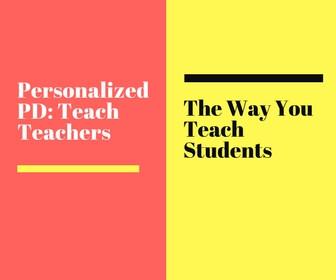Teacher visions are what I call the clear and distinctive images of classroom practices that are unique to each educator. These visions help inspire teachers’ instructional moves, determine how they feel about their teaching, and shape the decisions and goals they set for their professional learning. Many teachers could fill a composition book with their professional hopes and personal aspirations for their teaching and students.
However, as teachers encounter high-stakes accountability systems, including standardized testing and the pressures of school-based outcomes, those visions can get blurred. Add in the effects of pandemic disruptions and teaching can feel more like triage than progress toward bridging the gap between who we currently are in the classroom and who we want to be.
Given the increasing pressures teachers must navigate, it can be challenging to carve out the space we need to articulate and contemplate our teacher visions. As educators, we often push the act of creating and reflecting on visions to the bottom of our “must-do” lists in the face of competing priorities. But if we forgo them, we risk forgetting why we chose to teach in the first place.
Recommitting to our teaching aspirations and our intentions for our students even in the face of external pressures can provide the energy boost we desperately need now. Sometimes this process of recommitting can entail reframing our priorities or navigating professional challenges in new ways, which can make us better, more flexible educators.
Anytime Is the Right Time for Visioning
In my experience as a district leader, teachers with strong visions have greater personal and professional satisfaction. These ideal images of classroom practice help shape educators as independent thinkers who are more likely to meet their students’ needs because their teaching aligns with their values. Personal visions may focus on the teacher’s role as facilitator of learning rather than all-knowing instructor. They may also prioritize the moves and actions of students. For example, I’ve worked with teachers whose visions focus on the problem-based learning they want their students to engage in or the type of inquiries they want their students to investigate.
While a new school year's palpable excitement provides a perfect opportunity to re-engage with our teacher visions, the important work of crafting, enacting, and revising our visions is ongoing. This reflective work shouldn’t be relegated to the start of a new school year. Anytime we can incorporate our visions into our daily work, we’re able reconnect to the life force of teaching by maintaining professional focus and developing a unique sense of purpose.
Visioning is more than beginning-of-year goal setting. When we plan and instruct with an eye on our visions, we keep them top-of-mind. Rather than think of the creation and implementation of our visions as having a definitive beginning, middle, and end, think of visioning as ongoing and iterative.
Strategies for Getting Started
Teacher visions are akin to a living document. They should evolve, just like we do.
Using guided questions and easy-to-follow strategies, teachers can refresh their original visions—or try visioning for the first time. The strategies below can serve as a powerful way to reflect and get to the root of your personal teaching beliefs.
1. Start with Questions
When creating our visions, we can use a series of questions as prompts to help generate our thinking. While these questions aren’t in any specific order, nor do you have to answer all of them to author your visions, they do serve as useful frames to help you get started. Ask yourself:
- Why did I choose teaching as my vocation?
- What do I want to achieve as a teacher?
- What hopes and aspirations do I have for my students?
- What do I value as a teacher?
- How do these values show up in my teaching?
- How do I incorporate my vision into daily lessons and student interactions?
While visioning lives in a mental space, there is power in committing your thinking to writing. In written form, your visions become tangible aspirations to which you strive that can be adjusted as you grow your beliefs and practices over time.
2. Get Realistic: Overcoming Obstacles to Visions
We can’t sustain our visions if we view them through rose-colored glasses. In fact, when visions are too lofty and unrealistic, we’re unlikely to achieve them, making us prone to abandon our visions and see ourselves as hopeless failures.
To avoid this, proactively form a list of potential obstacles. From school or district mandates to follow scripted curricula to rigid teacher evaluation systems, there’s no shortage of complications. Spend time identifying the barriers to your visions and determine if those potential roadblocks are unmovable or can be nudged aside. Acknowledging what we can and cannot control allows us to better adapt our visions.
Our visions don’t have to conflict with our current reality. Instead, we can work to bridge the gap between the two. To adopt a mindset of bridge building, our visions need to be flexible. When challenges appear too significant to overcome, we can still find ways to enact our visions. Perhaps these challenges underscore the loftiness of our visions and we need to reflect on ways to make them more realistic and responsive within the current context. Perhaps these challenges don't allow us to teach to the entirety of our visions and we need to find moments during the day when we can incrementally teach to our visions. Over time, these small moments add up and put into focus the visions we at first thought our obstacles blurred.
3. Reconcile What You Believe Vs. What You Practice
As teachers, we benefit from reflecting on the gap between what we believe and what we practice. Consider it an exercise in mindfulness. We should evaluate the classroom environment and our instructional moves. Do they work to support our teacher visions or do they work against them?
We can move closer to our future goals by narrowing the space between our current and ideal practices—that is, by creating a metaphoric bridge between them. The work of getting from one side to the other requires constant reflection, risk-taking, and acknowledgment that we may always be striving to achieve our visions. That’s OK. Visions, by their very nature, are a distance away from our current reality. However, when we foreground them, we inch closer to their attainment.
Find Your Own Way
Visions ground us; they are one area we have control over. The agency they evoke reminds us that teaching is more than the skillful use of pedagogical moves we collect as best practices. When we create visions and prioritize them in our daily work, we’re empowered with a sense of agency rooted in the truth that teaching and learning do not allow for “one best way.”
We encourage our students to embrace their individualism and unique ideas. Let’s do the same for ourselves.








